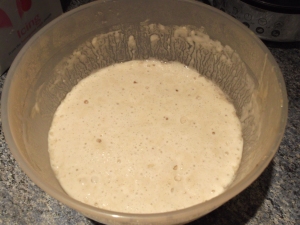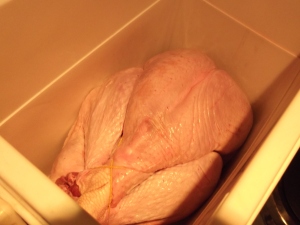These last few weeks I have been keeping a pet at home. It requires attention every day, and feeding regularly. It definitely smells. But that’s where the comparison stops, as this pet certainly isn’t fluffy, and doesn’t greet you looking for food when you get home at the end of the day. No, I’ve been keeping a sourdough starter, which we have taken to calling “Saccy”, after the latin name for yeast, Saccaromyces cerevisiae.
Sourdough starters are used, unsurprisingly, to make sourdough bread. My first experience of proper sourdough bread was on a windy pier in San Francisco, where we had one of the famous Boudin Bros. sourdough rolls hollowed out and filled with clam chowder. After eating the steaming hot clam chowder, we tore apart the bread, now soaked in creamy soup, and finished that off too. I found I wasn’t particularly a fan of the sour taste- something that puts a lot of people off sourdough bread- but the texture was fantastic. Another feature of sourdough bread, the idea of having a starter in the fridge that matures, and that you keep developing as you make more and more bread, really appealed too. So recently, as I have been getting more confident with making breads, I thought I would give making sourdough bread a go.
The interesting thing about sourdough starters is that they don’t contain any yeast- at least any added yeast. You simply take whatever yeasts are floating around in the air when you are making the starter, and by having plenty of flour available for growth, you’ve got a fermentation going. But the yeast isn’t all you get in the air. You also get some bacteria, and it’s these bacteria which produce acid, which makes the bread sour. The bacteria also prevent spoiling and reduce the speed at which the bread becomes stale, and before the industrialisation of baking, these were desirable features to have in bread. But these bacteria do have to be taken into account while cooking. According to Harold McGee’s McGee on Food and Cooking:
Because growing microbes consume nutrients rapidly, and produce acid and other growth-inhibiting substances, starters need to be divided and refreshed regularly, two or more times per day. Adding new water and flour dilutes the accumulated acids and other growth inhibitors, and provides a fresh supply of food. Aerating the starter- whisking a liquid one, or kneading a doughy one, supplies the oxygen that yeasts require to build cell membranes for new cells. The more frequently a starter is divided and refreshed, the better the yeasts will be able to grow, and the more leavening power the starter will have. (McGee on Food and Cooking, p545).
For logistical reasons, I can’t divide a starter two or more times a day, but if you are able to, you should get a better quality product. Here’s how I made my starter, based on a recipe from The Forgotten Skills of Cooking.
How to make a sourdough starter
Day 1: In a large bowl (1.5 litres was fine for me), put 50g strong white bread flour and 50g tepid water, give a good stir, cover, and leave for 24hrs.
Days 2-6: Add to the starter 50g strong white bread flour and 50g tepid water, give a good stir, cover, and leave for 24hrs.
According to McGee, the yeasts grow optimally at 20-25ºC, whereas the bacteria grow optimally in a warmer environment, at 30-35ºC. For this reason, you don’t have to worry about keeping the starter any warmer than room temperature. This also applies to the dough, so the usual rules of sticking the dough somewhere warm to rise or prove don’t apply.
Once you’ve got the starter, you can begin to make the actual bread. Because of the acids present, sourdoughs are not particularly good risers, even when you give them ideal growing conditions. Consequently the rising times are very long, days in some cases, so make sure you are organised before trying to make some of this bread. Similarly, don’t expect the same kind of lift in the oven that you get from normal bread- my loaf ended up rather flatter than I expected. Again, because of the acid, sourdough loaves are often slightly saltier, as this limits the bacterial growth and helps tighten the gluten networks. Otherwise, making sourdough bread is very similar to making regular bread.
Despite it being my first attempt, I got pretty reasonable results. As I said, the dough was quite flat, but I wouldn’t say it was dense, as my first attempts at regular bread were. I made my starter our of strong white bread flour, but different types of flours will give you starters that work in slightly different ways, so it might be that I try a spelt starter, for example. But I guess these are all things I can begin to explore once as my starter matures, and as I start to understand the chemistry going on.
Sourdough bread
This recipe is adapted from one in The Forgotten Skills of Cooking. I made one large loaf with these quantities. Reminder: the rising and proving times are long, so make sure you are organised before you try to make a loaf.
Ingredients:
1 sourdough starter, as described above
600ml tepid water
1.15kg strong white bread flour
2 tbsp rye flour
Recipe:
1. Make the starter. See above.
2. Make the foam. Add 225g of flour and 225g water to the starter. Mix well, then cover and leave overnight. The next morning, add 225g flour and 225g water, mix well, and leave for 5-6 hours. When this is done, take out 450g to be your starter for the next loaf (you can refrigerate this for around two weeks).
3. Make the dough. Add the remaining ingredients and mix well. Knead (ideally in an electric mixer) for 6 minutes. Cover and leave for around 6-8 hours until the dough has doubled in size. Knock back the air, shape into loaves or baguettes as desired, then dust generously with flour. Cover and put in the fridge overnight.
4. Make the bread. Return the dough to room temperature and leave for around an hour. Preheat the oven to 230ºC. Bake for 35 minutes, leaving to cool on a wire rack when the bread is done.





























